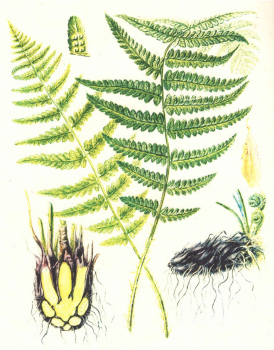The sporophyte develops a cluster of large leaves above ground. The leaf blade is dark green, with an elongated-elliptical outline (distinctive of other species), and is bipinnate; the second-order lobes have blunt teeth (never needle-like, distinguishing it from the needle fern). The petiole of the leaf is densely covered with rusty-brown scales, swollen at the underground base, and remains on the rhizome after the leaf dies. Sporangia on the underside of the leaf are grouped into sori and covered by a kidney-shaped indusium (different from the female fern, which has elongated indusia). The rhizome is large, thick, and inclined in growth.

It grows in damp forests in deep shade. The male fern’s range is fragmented. The primary region is in the European part, where it grows in spruce and mixed spruce-deciduous forests, green mossy areas, and among shrubs; in broadleaf zones, it is usually found in oak forests. The largest populations are in the central region and along the Volga. Smaller, isolated populations occur in mountainous areas. In the Caucasus, it forms large populations in beech mountain forests, in Central Asia in Tian Shan (under Schrenk spruce), and in Siberia (Altai and Sayan) in spruce-fir taigas.
The rhizome of the male fern (Rhizoma Filicis maris) is harvested in autumn (August-October), removing small roots, dead parts, and dried petiole parts. The cylindrical, underground bases of the petioles are left, layered on the rhizome with fine brown scales between them. Drying is done in the open air or dryers at 40 °C. Rhizome stocks are renewed annually since the active substances decompose during storage. Preparations are made in autumn from fresh, dried rhizomes; these rhizomes appear green when broken. The total active substances of the male fern form a dark mass called «raw filicin.» Several crystalline substances have been isolated from raw filicin. The main one in quantity and effect is filicic acid (pure filicin); lesser compounds include flavaspidic acid and albaspidin. These substances are methylated derivatives of phloroglucinol with butyric acid.
The rhizome is used as an anthelmintic against tapeworms. A galenic preparation, an ethereal extract, is prescribed in gelatin capsules of 0.5 g. A diet and saline laxative are followed a day before taking the preparation. On the next day, the preparation is administered (to adults) in 2–8 g over 30 minutes, i.e., 16 capsules, followed by a saline laxative 2 hours later. If necessary, the treatment can be repeated a week later (2–3 times). The maximum single dose of the extract for adults is 8 g.
Some other species of the genus Dryopteris, containing phloroglucinol derivatives and also possessing anthelmintic properties, form large populations in forest zones of the European part, the Caucasus, and the Far East. In Japan, the closest species or its variety, Dryopteris crassirhizoma Nakai, has been traditionally used. Other species of this genus are being studied. An unacceptable admixture is the female fern (Athyrium filix-femina Roth), which grows in the same forests.
